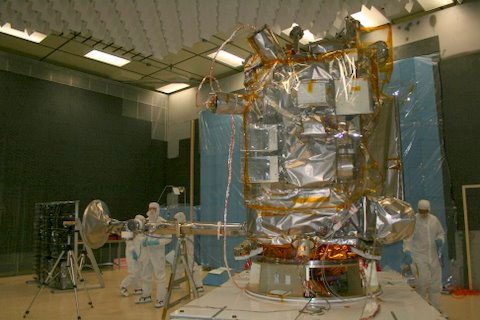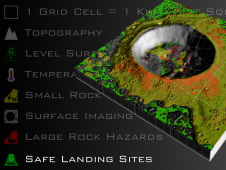
 Aug 29 - The LRO team rehearsed the first five days of the mission. During this test, we operated the Orbiter as if it were in space, with the control team at the Mission Operations Center and the engineering team in the Launch Support Room.
Aug 29 - The LRO team rehearsed the first five days of the mission. During this test, we operated the Orbiter as if it were in space, with the control team at the Mission Operations Center and the engineering team in the Launch Support Room.
> More
+ Assembly Progress
 Robot Scout: Fly Me (Safely) to the Moon Robot Scout: Fly Me (Safely) to the Moon
Sept 5 . The first attempt to land humans on the moon was a triumph that almost ended in disaster. The landings for NASA's return to the moon are likely to be even more challenging.
|
 NASA Tests Moon Imaging Spacecraft at Goddard NASA Tests Moon Imaging Spacecraft at Goddard
July 31 . LRO has completed the first round of environmental testing which ensure the spacecraft is prepared for its mission to collect the highest resolution images and most comprehensive geological data set ever returned from the moon.
|
 One Million Names to the Moon One Million Names to the Moon
June 20 . A million names will be blasted into space and "to the moon" on LRO. That's how many people have submitted their names to this project.
+ LRO Newsroom
|
|
|  |
| The Lunar Reconnaissance Orbiter is the first mission in NASA's Vision for Space Exploration, a plan to return to the moon and then to travel to Mars and beyond. The LRO objectives are to finding safe landing sites, locate potential resources, characterize the radiation environment, and demonstrate new technology. > More
|
Safe Landing Areas
This is a simulated map of safe landing areas around a large lunar crater, representing those that will be created using data from LRO.
 The green regions are designated as possible safe landing zones after LRO's instruments have scanned the surface for various hazards, such as steep slopes, extreme temperatures and rocky terrain. Once the maps have been created, mission planners will choose safe zones that are also scientifically interesting or are near possible resources. > Watch Video
The green regions are designated as possible safe landing zones after LRO's instruments have scanned the surface for various hazards, such as steep slopes, extreme temperatures and rocky terrain. Once the maps have been created, mission planners will choose safe zones that are also scientifically interesting or are near possible resources. > Watch Video
|
|
+ More Videos
|

|
